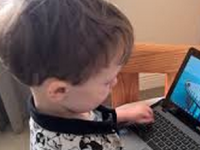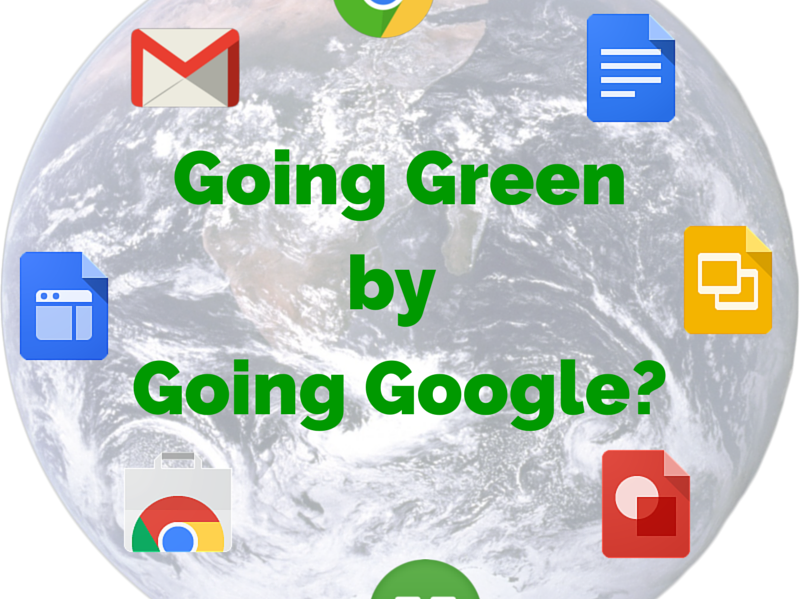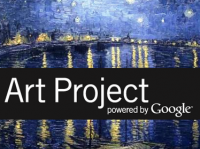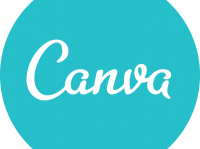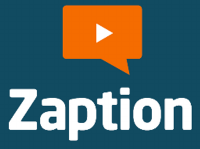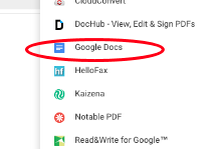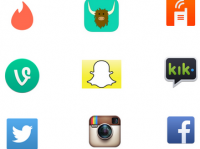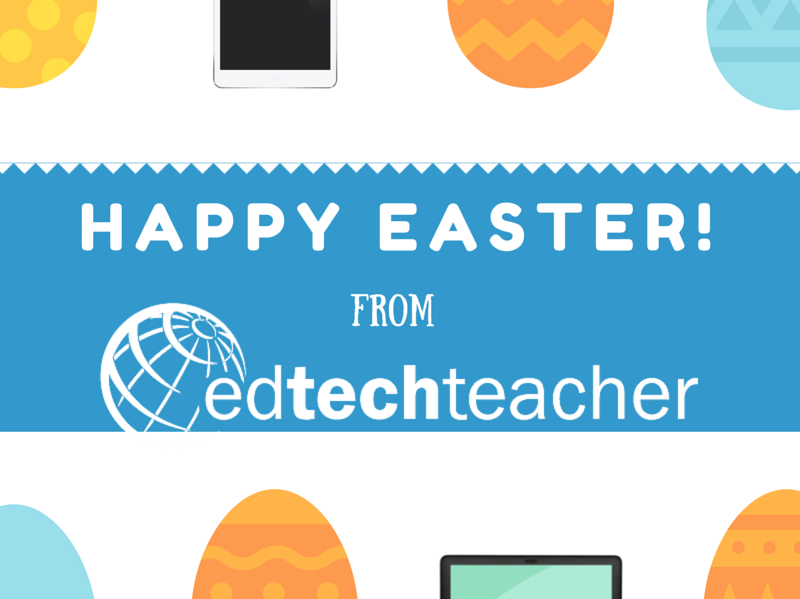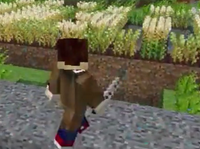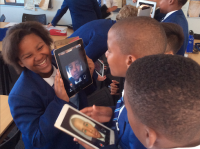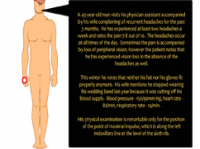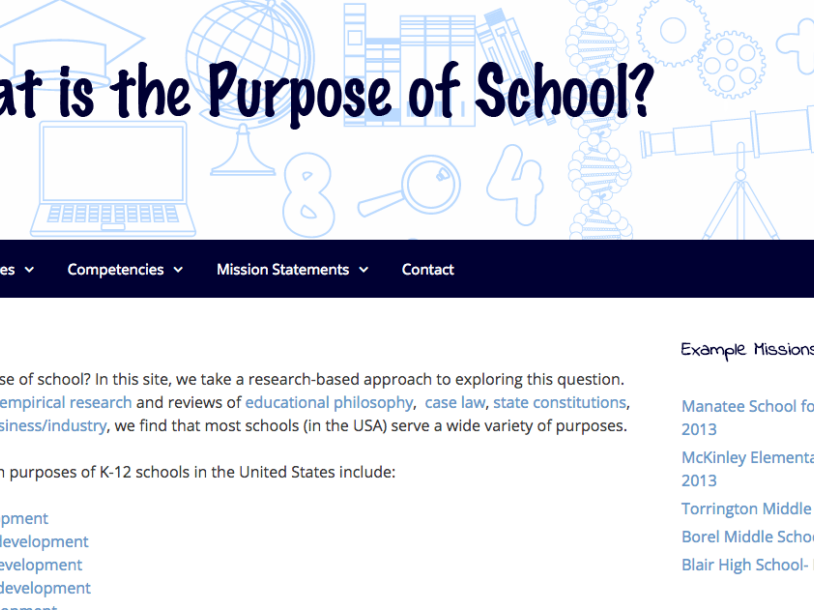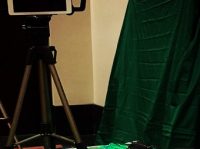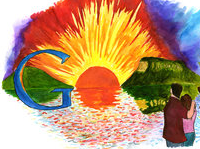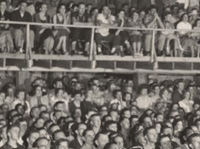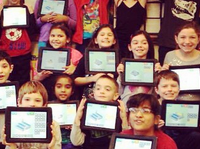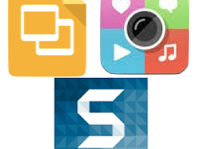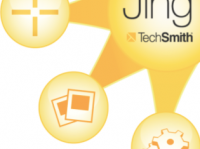The EdTechTeacher Blog
EdTech Resources & Strategies for Teachers
Subscribe to receive updates on our newest blog posts and resources!

- All
- Blog
- Featured
- Project Based Learning
This article was first published in the May Edition of Educational Leadership from ASCD. Getting computing devices into schools is relatively easy; changing classroom practice with technology is really, really hard. Over the past century, radio, television, video cassette recorders, desktop computers, laptop computers, handheld devices, tablets, and cell phones have all been heralded as potentially transformative classroom tools (Cuban, 1986, 2003). With every generation of computing technology, a small group of educators has been able to use new tools in transformative ways, but on the whole, classroom practices have proven stubbornly resistant to change. Consider this thought experiment: If you…
This article first appeared on eSchoolNews. … I could start my workshops by showing teachers how to find and do everything. I could lead them through a step-by-step, do-what-I-do tutorial of various apps —“point here, click there”—and teachers could simply watch what I do and then repeat what I do. But the problem with that approach is, by the end of the workshop, it creates a culture of dependency. The instructor ends up the center of the learning, not the students, and disseminates information to a mostly passive audience. I’m simply not empowering them to learn if I’m at the center…
This post first appeared on Daily Genius. Blogging is a popular activity in classrooms today because it allows students to share their writing with a broader audience and teachers to communicate with parents. There are a myriad of platforms to choose from: edublogs, Kidblog (especially good for elementary age children), Blogger, wordpress, and most LMS systems have a blogging platform built in. How to set up a blog will depend on your platform, and is pretty easy to figure out with all of the “how-to” videos and help center collections. What teachers most often ask me is why they would…
[View the story “Weekly Resources to Kick Off May” on Storify]
This post first appeared on Daily Genius. Providing access to more than just apps, Google Chromebooks are the perfect tool to build the foundation for technology success in young students. Throughout my years as a K-8 technology teacher & coordinator, many people have asked me what Kindergartners, first graders, and second graders might truly do with computers in the classroom. As students reach the intermediate grade levels, it is easier for people to imagine what they will do with technology. They will utilize word processors to write essays; they will construct videos to demonstrate knowledge; they will work within a…
This post first appeared on Free Technology for Teachers. As more schools go 1:1, teachers often feel challenged to make their traditional lessons and activities more interactive. One of my favorite free tools is Pear Deck because it allows a teacher to take a PowerPoint, Google Presentation, or PDF and incorporate various student activities to check for understanding and engagement. Pear Deck is free for students and teachers (with a higher end, paid premium model) and it fully integrates with Google Apps for Education. When you sign in to your Pear Deck account, create a new interactive lesson by selecting…
[View the story “Weekly Resources to Wrap up April” on Storify]
This post first appeared on Daily Genius. Google Art Project is one of my favorite tools available online. It is a repository of high resolution images and 3D “museum view” virtual art gallery tours. Since its inception in 2011, Google Art Project has grown from its initial collaboration of 17 international museums to more than 151 and is now available in 18 languages. This is a great tool for introducing students to Art from around the world. Here are a few ideas for lesson plans that you can use in conjunction with Google Art Project. Create & Curate a Gallery…
This guest post from Summer Workshops Instructor, Suzy Brooks, first appeared on Free Technology for Teachers. Over the years, I have witnessed the power of social media and the draw of compelling images in the classroom. My students love connecting with others globally, and they are inspired by interesting photographs. Having a broader audience and a topic to write about is oftentimes all I need to turn student writers into published authors. With Write About,I have found a free tool that puts the power of both social media and images into the hands of my students. Write About is a…
Back in December, Amy Burvall (@AmyBurval) created the video below about Exploring Critical Thinking with Visual Literacies. She stressed the need for students to develop visual literacy in addition to text decoding and oral communication skills. As media continues to move towards more image-based communication, she notes that students not only require the ability to interpret it, but also create it. Amy’s message struck a chord with me, particularly because I typically don’t consider myself as very visual. Despite my best efforts, I do not have the best drawing or visual-spatial skills. In workshops, I struggle with teaching certain tools and apps because…
[View the story “Weekly Resources for Mid Spring” on Storify]
This post first appeared on Edutopia. Regularly, teachers tell me that they don’t feel as though they have time for project-based learning (PBL). While they like the idea in theory, they can’t see a way to realistically “fit it in” with their curriculum given constraints of time, testing, standards, etc. A regular response to the concept of PBL is: “It sounds great, but. . . ” Too often, they see it as a manufactured experience that results in the construction of a massive project and requires enormous amounts of class time. However, I believe that this is often because the…
This post first appeared on Free Technology for Teachers. Video has become a more ubiquitous element in education today: YouTube Videos, Kahn Academy, Flipped Content, iTunes U, and more. However, most teachers don’t want their students passively absorbing content. Rather, they want to make sure that students are engaged with the material. A great tool for incorporating more responsive features in your lessons is Zaption, which you can use to create interactive videos via a web browser or their free iOS App. While Zaption does offer a robust, subscription model, the free tool will allow teachers to do a lot…
This post first appeared on Diversa. Over the past few months, in a number of different contexts, an interesting question has presented itself. When teaching about the power of text-to-speech, several teachers have asked whether or not it could have a long-term, detrimental impact. These thoughtful educators question if being able to hear words could actually decrease literacy skills and remove the need for students to learn to read. However, a 2013 report indicates that eReaders are More Effective than Paper for Some with Dyslexia. Researchers found that the “use of the device significantly improved speed and comprehension, when compared…
[View the story “Weekly Resources for Mid April ” on Storify]
This guest post post from Summer Workshop instructor, Brenda Doucette (@doucetteb), first appeared on Free Technology for Teachers. Recently, we discovered a feature of Google Drive that has changed how we prepare and access materials and resources for our students. As we attempt to make all curricula digital and thus make it available to all students, the idea of using PDFs was always a problem. PDFs are just not editable in most situations, and this was an issue when it came to modifying and differentiating documents. Adobe Acrobat was our “go to” application for this type of conversion, but it was costly and…
This post first appeared on Free Technology for Teachers. How many of the above tools did you recognize? Do you know which ones are safe and which ones are harmful? Do your students or children know the difference between them? How many of the above tools frighten you as a parent or a teacher? As the world becomes smaller, and children are surrounded by a variety of different communication tools, it’s time for us as adults to reevaluate what we mean when we teach children the classic lesson, “Don’t talk to strangers.” The term “talk” used to be limited to…
http://www.youtube.com/watch?v=Aqz7s9W1KdgJoin UsThe video above will be a LIVE STREAM of the webinar. This webinar is broadcasted for free using Google Hangouts on Air. Press play or refresh if the video doesn’t begin at the indicated time. Please introduce yourself in the chat window below and feel free to ask questions at anytime. Description: Speakers: ChatPresenter’s Slides
http://www.youtube.com/watch?v=aYmCLOWp-IcJoin UsThe video above will be a LIVE STREAM of the webinar. This webinar is broadcasted for free using Google Hangouts on Air. Press play or refresh if the video doesn’t begin at the indicated time. Please introduce yourself in the chat window below and feel free to ask questions at anytime. Description: Speakers: ChatPresenter’s Slides
http://www.youtube.com/watch?v=o0pLt3l2tIwJoin us April 14th at 4pm EST/ 1PM PSTThe video above will be a LIVE STREAM of the webinar. This webinar is broadcasted for free using Google Hangouts on Air. Press play or refresh if the video doesn’t begin at the indicated time. Please introduce yourself in the chat window below and feel free to ask questions at anytime. Chat:Presenter’s Slides:
This post first appeared on Daily Genius. One of my favorite Google Apps resources is Google Calendar. If your school has enrolled in Google Apps for Education, it is part of your GAFE suite of tools. With a Google Calendar, you can more effectively organize and plan your administrative tasks. Here are some quick tips to help you to effectively wield your Google Calendar tools. Use a Shared Calendars With Shared Calendars, multiple people can view and even edit the same calendar. It’s easy to manage a shared calendar with your Administrative Team, Clubs, Faculty, or even parents using Google Calendar. You…
[View the story “Weekly Resources for Easter Weekend” on Storify]
This post first appeared on Free Technology for Teachers. Learning to read and write don’t have to be independent tasks with a new app called WriteReader, a literacy based learning platform where children from the age of three can create or participate in creating their own books. WriteReader begins by having students create a book and is designed for children to work with adults. The keyboard is specially designed to speak the sound of the letters as they are being typed. To further support children, vowels are outlined in blue and consonants are outlined in red. The book has a…
[View the story “Weekly Resources for the End of March” on Storify]
This guest post from Anthony Peters (@apeters522), educator at Parklands College in Cape Town, first appeared on Daily Genius. Having completed the wondrous Romeo and Juliet text for Grade 9, the time had come to investigate the deeper intricacies of Shakespeare’s wonderful work! Instead of simply going through the various motifs, themes and symbols inherent within the play, the English Department at Parklands College put a far more intriguing spin on it by App Smashing Blippar, Socrative, and Padlet. These three extremely useful applications enabled teachers to research, collaborate, and build a revision tool in order to intrigue the minds of the learners and get them…
This guest post from Courtney Pepe (@iPadQueen2012) first appeared on Daily Genius. Jean Piaget once said that “play is the answer to how anything new comes about.” As educators in the digital age, it is important that we embrace the power of play in our classrooms. One of the ways that we can redefine our practice is by using game education in our schools. Game education is a powerful way to engage 21st century learners in a variety of cognitively complex tasks that lead to deeper levels of understanding. Educational games help students to learn about certain subjects, expand their…
[View the story “Weekly Resources for the 1st Day of Spring” on Storify]
This guest post from Anthony Peters (@apeters522) first appeared on Daily Genius. Typically, concepts like nouns and parts of speech are thought of as terrible, tedious, and troublesome concepts that can lead to learners to becoming tired, terrified and perhaps – in the extreme cases – tearful! With that in mind, learners at Parklands College in Cape Town brought Morfo into the mix. Not only did they make some wonderful creations and have lots of fun, but they also compounded the linguistic knowledge of the lesson. After previously completing a work on eight variations of noun (e.g. proper, compound, concrete, abstract), the learners were…
This guest post post from Summer Workshop instructor, Brenda Doucette (@doucetteb), first appeared on Free Technology for Teachers. Recently, some of our 6th graders came into the computer lab to do research using Google Earth. The teachers on the 6th grade team had spent many hours digitizing curriculum and making Google Earth Tours (.kmz files) for their students as it is a wonderful way for students to experience the world around them. Today’s lesson was a tour of Europe’s Physical Features – complete with embedded videos, text and images. One particular group seemed to be having some trouble reading the text…
This post first appeared on Daily Genius. One of the most effective ways for Administrators to empower and encourage their faculty to use new and innovative tools is to model best practices by employing them in their own administrative duties. Google Docs, a tool within Google Drive, includes a number of robust features that can streamline your administrative duties and highlight their ability to foster collaboration among peers and students. If you need a quick tutorial on Google Drive, check out this article on Daily Genius. Here are four ways that Administrators can use Google Docs to both streamline their…
This post first appeared at Inside Higher Ed. Tom Daccord and Justin Reich, founders of EdTechTeacher say it best, “Technology should be used in the service of learning.” It is with this philosophy in mind, that Maria Maldonado, a practicing Physician Assistant and Instructor at the Keck School of Medicine at the University of Southern California (USC) Physician Assistant program, chose to re-examine how iPads were being used for teaching and learning in her curriculum. She saw the ubiquity of technology use for her students and recognized that they learn differently today. Maria decided to begin with an upcoming module on endocrinology that in years past she noticed had been challenging for…
This post first appeared on Daily Genius. The Google Apps for Education suite includes a number of robust tools that can streamline administrative tasks. In addition to making your job as an administrator easier, using them allows you to model effective technology adoption with your staff. One of my favorite tools to tackle this type of tasks is Google Forms, one of tools within Google Drive. Here are five ways that Administrators can use Google Forms in their schools. Classroom Observations Classroom observations are a key tool for evaluating faculty and providing them valuable feedback. One way to make providing…
This post first appeared on MindShift. Helping students become networked learners begins by thinking carefully about where we conduct our online learning. Most online learning in higher education and in K-12 takes place in Learning Management Systems (LMS) such as Canvas, Moodle or Blackboard. In higher education in particular, these LMS are designed to scale up the distribution of course materials — by default they are configured to distribute syllabi, course readings and assignments. Student contributions are usually limited to discussion forums and assignment submissions. Since these are institutionally managed spaces, students can lose control over what they submit to…
Dr. Damian Bebell, assistant research professor at the Center for the Study of Testing, Evaluation, and Data kicked off the afternoon. He is a researcher and not a practitioner, so he brings a new perspective to the conference. How do we study the impact of educational technology? This is the first big question that Damian asks. He says that in doing that, we need to define outcomes, measure access, measure use, and examine the relationship between access, use, and outcomes. When looking at the impact of 1:1 access on education, Damian then shows the ration of students to computer over time. In 1983,…
Eric Sheninger, Senior Fellow and Thought Leader on Digital Leadership with the International Center for Leadership in Education (ICLE)and Scholastic Achievement Partners (SAP), kicked off the 2015 Leading Future Learning conference with his keynote on Digital Leadership. A former award-winning principal from New Milford, NJ, he is currently the K-12 Director of Technology and Innovation in the Spotswood School District (NJ). Eric’s journey started about 10 years ago when he was hired to be an administrator in the New Milford school district in New Jersey. Despite being surrounded by “high performing” schools, New Milford was not one of them. 30% of…
This post first appeared on Daily Genius. Two schools are both alike in dignity. Part of our story takes place in Jersey City, NJ while the other part takes place 32 miles away in Roslyn, NY. Some would argue that this is the best of times and the worst of times in education. This case study will celebrate what is good about education today by presenting two stories that illustrate how Green Screen technology on iPad can be used to support authentic student voice in learning environments on different ends of the educational spectrum. School #1 – Roslyn High School,…
This post first appeared on Free Technology for Teachers. I have been a huge fan of Diigo for quite some time. Unlike other social bookmarking sites, Diigo allows me to save links from any device, tag them, and even create collaborative groups such as this one on iPads. It will also allow me to highlight and add notes within the text of any web article and then save those notes to my Diigo Library from any computer, iOS, or Android device. The video tutorial below from Greg Kulowiec gives a great overview of what is possible when using Diigo via…
[View the story “Weekly Resources from iPad Summit South Africa and more!” on Storify]
This post first appeared on Daily Genius. Introducing a new technology into the learning environment can be an intimidating experience, even for seasoned educators. However, with careful and intentional planning on the part of administrators and educational leaders, they can become powerful tools as part of your curriculum and pedagogy. Here are eight ways that administrators and school leaders can empower their faculty to successfully adopt technology in their curriculum. Is the Technology on Your School or in your School Greg Kulowiec, in his talks on iPads and other mobile devices, is fond of asking “Is your technology on your…
What does the 21st Century classroom look like? That’s the question educators and exhibitors asked this week at the EdTechTeacher iPad Summit in San Diego, California. TIME FOR KIDS exhibited at the summit—and connected with innovative educators to learn how they are using technology to bring the world to students. On many levels, the modern classroom isn’t all that different from classrooms of previous generations. Teachers are as eager as ever to connect with students, share knowledge, teach skills and motivate learners. Students continue to be hungry for information. What is different today is the degree to which technology allows…
This post first appeared on Edutopia. Recently, I wrote about the transformation of libraries from archives of resources to active learning commons that encourage exploration, creation, and collaboration. However, in that post, I profiled a number of locations that made significant financial investments in their redesign. Million-dollar learning spaces are often not a reality for most schools. However, that is no reason to abandon the concept of transformation. Here are four suggestions from librarians and educators who have transformed their learning spaces — even without a budget. Tip #1: Create an Agile Space Tip #2: Design an Inviting Space Tip…
This post first appeared on Daily Genius. One of the most ubiquitous tools in educational technology today is Google Drive. If you’re unfamiliar with Drive, think of it as two elements: Online “cloud” storage where you can throw files of all sizes (up to 1TB) and access from everywhere A scaled down office suite that includes docs, sheets, and presentations tools. If you would like get to know Google Drive, here are 5 tips to help you get started. While you can use Google Drive with any browser, I urge you to use Google Chrome (free for all devices), as…
[View the story “Weekly Resources from iPad Summit San Diego” on Storify]
Douglas Kiang is both a member of the EdTechTeacher instructional team as well as teaches computer science and heads the technology resource teachers group at Punahou School in Honolulu, Hawaii. He holds a Master’s Degree in Technology, Innovation, and Education from Harvard and is an Apple Distinguished Educator. In addition to being an important thought-leader who addresses how technology reshapes our teaching, our classrooms, and learning spaces in general, he is the author of five bestselling game strategy guides and his latest book on Minecraft in Education is soon to be published by Peachpit Press. What is the Classroom of the Future? Douglas…
Welcome to the 2nd annual EdTechTeacher iPad Summit in San Diego! Over 500 educators from around the world have joined together to explore the potential and possibilities for iPads in the classroom. To kick off this event, Alec Couros (@courosa), Associate Professor of educational technology and media at the Faculty of Education, University of Regina is giving the opening keynote. Alec has given hundreds of workshops and presentations, nationally and internationally, on topics such as openness in education, networked learning, social media in education, digital citizenship, and critical media literacy. His graduate and undergraduate courses help current and future educators understand how…
[View the story “Weekly Resources to Kick off February” on Storify]
This post first appeared on Daily Genius. Google has become one of the most popular tools in schools today. With its broad and flexible system of apps, there are many ways to adapt them into a classroom to help you explore new and dynamic ways of presenting materials or having students build projects! If you teach in the art department (with either Studio Art or Art History), here are three ways to use Google to facilitate your classroom workflow and to allow students to showcase their work. Google Docs for Write-Ups Google Docs is a quick and easy to master…
This is a guest post from iPad Summit San Diego featured presenter, Dr. Reshan Richards (@ReshanRichards). It first appeared on EdTechResearcher. I have recently been writing about the qualitative formative assessment toolkit (QFAT for short) which is something that has come out of my research on and practice with mobile devices, multimedia, and formative assessment. It is comprised of four media authoring approaches available on most smartphones, tablets, and laptops: making photos, taking screenshots, filming videos, and screencasting. Each of these approaches allow teachers and learner to capture and create moments of learning, excerpts of understanding, and reflections of experience. Let’s pretend to be one of my…
This post first appeared on Daily Genius. In 2014, Chromebooks surpassed iPads in the world of education. There are a variety of reasons for this: economic needs, more “laptop like” feel, and the ubiquity of Google Apps for Education in schools. If you find yourself the owner of a new Chromebook, you’ve probably noticed that it’s not quite a laptop, but it also isn’t a tablet. Chromebooks are actually their own unique tool outside of these categories. They are just different enough that they can require a little time to get used to. Here are some quick tips to help…
This post first appeared on eSchool News. Too often, we see teachers putting the proverbial cart before the horse. They find an app or tool they like, so they introduce it in their classroom. The students might find it cool and engaging—but if the teacher hasn’t defined whythey’re using that tool, its integration has no clear, educational purpose. If, instead, you begin with a learning goal in mind and choose apps and devise activities in support of it, then you’re on a path to meaningful technology integration. To help educators develop a vision for using technology in their classrooms, here…
Whether you spent the week buried under snow or in sunny places like San Diego where we have our upcoming iPad Summit. This week we had many new resources from webinars to blog posts to share. Articles from the EdTechTeacher and iPad Summit presenters Just in case you missed some of our more recent posts, here they are! Wisdom from David Bowie? – Guest Post from Gregg Russell 3 Easy Ways to Increase Learning Using an Authentic Audience – From Rhoda Hahn Explore the World with the Google Cultural Institute – From Jennifer Carey Getting Ready To Go 1:1 FAQ’s – From…
This guest post from Gregg Russell (@greggrussell12) first appeared on EdTechResearcher. The other night, David Bowie’s epic tune Changes, came blasting over the radio. As I was singing along to the lyrics, the phrase “I watch the ripples change their size but never leave the stream,” really struck a chord with me. It made me think about how often we attempt to change our schools but in actual reality, we rarely do. Our instruction and classrooms don’t look much different then they did decades ago. Our ripples rarely leave the stream indeed. This especially rings true when it comes to…
This guest post from iPad Summit San Diego presenter, Rhoda Hahn (@mrshahn), first appeared on Daily Genius. Long gone are the days of students reading textbooks, memorizing, and regurgitating information. Let 2015 be the year of increasing engagement and learning in your students. Giving students a real audience to showcase what they know can increase their sense of purpose, which can lead to a deeper understanding of what you want them to learn everyday in your class. If you’ve given your students a “pretend” audience, try some of these easy ways to boost learning and give students a real audience:…
This post first appeared on Free Technology for Teachers. I am a big fan of the Google Cultural Institute; it’s an amazing repository of Artistic Masterpieces, Wonders of the Natural World, Historical Artifacts, and more. By using it as a repository of digital materials, it’s an easy way to access cultural content from around the world in my classroom. I can pull up a high definition image of Van Gogh’s Starry Night and use its powerful zoom features so that students can see the impasto brush strokes. We can explore the Street Art of Sao Paulo with a Google Street…
This post first appeared on Patrick’s blog – Learning in Burlington. As a school district that has implemented a 1:1 initiative where every student is provided an iPad, we get frequent inquiries from other communities looking to begin similar programs. Back in 2011-2012 school year as our 1:1 Planning Team began the process of setting the stage for year one of this initiative, we had more questions than answers. Interestingly, each school district that we speak with regarding our 1:1 journey has many of the same questions. With this in mind, I thought it would be worthwhile to share some…
This guest post from Bart Buckinx (@bartbuckinx) first appeared on Daily Genius. As a teacher, you are used to create your own lessons. The xerox, Microsoft Word, and PowerPoint are your trusted companions. But how can you effectively use iPads in your lessons? The ebooks provided by publishers are mostly static and just not interesting enough for today’s students. Some educational apps are great, but finding the rights ones, figuring out how they work and getting them installed on all student devices can be a hassle. Aren’t there easy ways to create your own materials for iPad? Yes, there are! Try these:…
This post first appeared on Edutopia. From tablets and scrolls to bound books, libraries have cataloged resources and served as a locus of knowledge. Today, they are reinventing themselves as content becomes more accessible online and their role becomes less about housing tomes and more about connecting learners and constructing knowledge. Printed books still play a critical role in supporting learners, but digital technologies offer additional pathways to learning and content acquisition. When every student has the potential to carry a global library on the device in his or her pocket, the role of physical libraries may become even more important, not just…
[View the story “Weekly Resources for Mid January” on Storify]
This post first appeared on Free Technology for Teachers. With Chromebooks being adopted as the 1:1 tool of choice in schools throughout the country, it is helpful to note that there a number of options that allow for student creation that go beyond the suite of Google tools. One example of this creative potential takes advantage of a staple in the Google Apps library, Slides, and works in combination with Thinglink as well as the Chromebook screencasting option from TechSmith, Snagit. In the image below, the process is outlined where a student could create an image or poster in Google…
This post first appeared on Free Technology for Teachers. I have long been a fan of Jing, TechSmith’s free screen capture software. It’s a fast and easy way to grab a quick screenshot or record a video on the fly. Recently, TechSmith upgraded Jing to include a FREE membership to Screencast.com; you now get 2GB of free storage and 2GB of bandwidth per month. Screencast.com allows you to safely upload and store video as well as images, to control who views your content, to download media in a variety of formats, and to share content in a myriad of ways. After…





